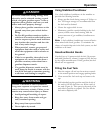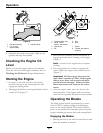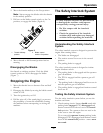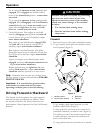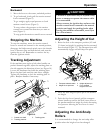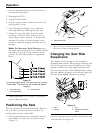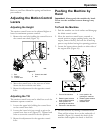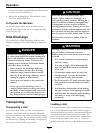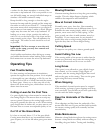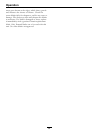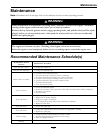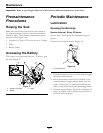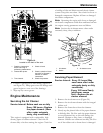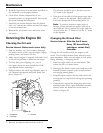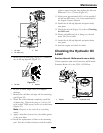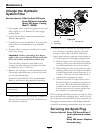
Operation
a surface for the frame members to contact if the
unit starts to tip backward. If it is not possible to use
one full width ramp, use enough individual ramps to
simulate a full width continuous ramp.
Ramp should be long enough so that the angles
between the ramp and the ground and the ramp and
the trailer or truck do not exceed 15°. A steeper angle
may cause mower deck components to get caught as
the unit moves from ramp to trailer or truck. Steeper
angles may also cause the unit to tip backward. If
loading on or near a slope, position the trailer or
truck so it is on the down side of the slope and the
ramp extends up the slope. This will minimize the
ramp angle. The trailer or truck should be as level
as possible.
Important: Do Not attempt to turn the unit
while on the ramp, you may lose control and
drive off the side.
Avoid sudden acceleration when driving up a ramp
and sudden deceleration when backing down a ramp.
Both maneuvers can cause the unit to tip backward.
Operating Tips
Fast Throttle Setting
For best mowing and maximum air circulation,
operate the engine at the Fast position. Air is required
to thoroughly cut grass clippings, so Do Not set the
height-of-cut so low as to totally surround the mower
by uncut grass. Always try to have one side of the
mower free from uncut grass, which allows air to be
drawn into the mower.
Cutting a Lawn for the First Time
Cut grass slightly longer than normal to ensure that
the cutting height of the mower does not scalp any
uneven ground. However, the cutting height used in
the past is generally the best one to use. When cutting
grass longer than six inches tall, you may want to cut
the lawn twice to ensure an acceptable quality of cut.
Cut 1/3 of the Grass Blade
It is best to cut only about 1/3 of the grass blade.
Cutting more than that is not recommended unless
grass is sparse, or it is late fall when grass grows more
slowly.
Mowing Direction
Alternate mowing direction to keep the grass standing
straight. This also helps disperse clippings which
enhances decomposition and fertilization.
Mow at Correct Intervals
Normally, mow every four days. But remember,
grass grows at different rates at different times. So to
maintain the same cutting height, which is a good
practice, mow more often in early spring. As the
grass growth rate slows in mid summer, mow less
frequently. If you cannot mow for an extended
period, rst mow at a high cutting height; then mow
again two days later at a lower height setting.
Cutting Speed
To improve cut quality, use a slower ground speed.
Avoid Cutting Too Low
If the cutting width of the mower is wider than the
mower you previously used, raise the cutting height
to ensure that uneven turf is not cut too short.
Long Grass
If the grass is ever allowed to grow slightly longer
than normal, or if it contains a high degree of
moisture, raise the cutting height higher than usual
and cut the grass at this setting. Then cut the grass
again using the lower, normal setting.
When Stopping
If the machine’s forward motion must be stopped
while mowing, a clump of grass clippings may drop
onto your lawn. To avoid this, move onto a previously
cut area with the blades engaged.
Keep the Underside of the Mower
Clean
Clean clippings and dirt from the underside of the
mower after each use. If grass and dirt build up inside
the mower, cutting quality will eventually become
unsatisfactory.
Blade Maintenance
Maintain a sharp blade throughout the cutting season
because a sharp blade cuts cleanly without tearing or
shredding the grass blades. Tearing and shredding
27



